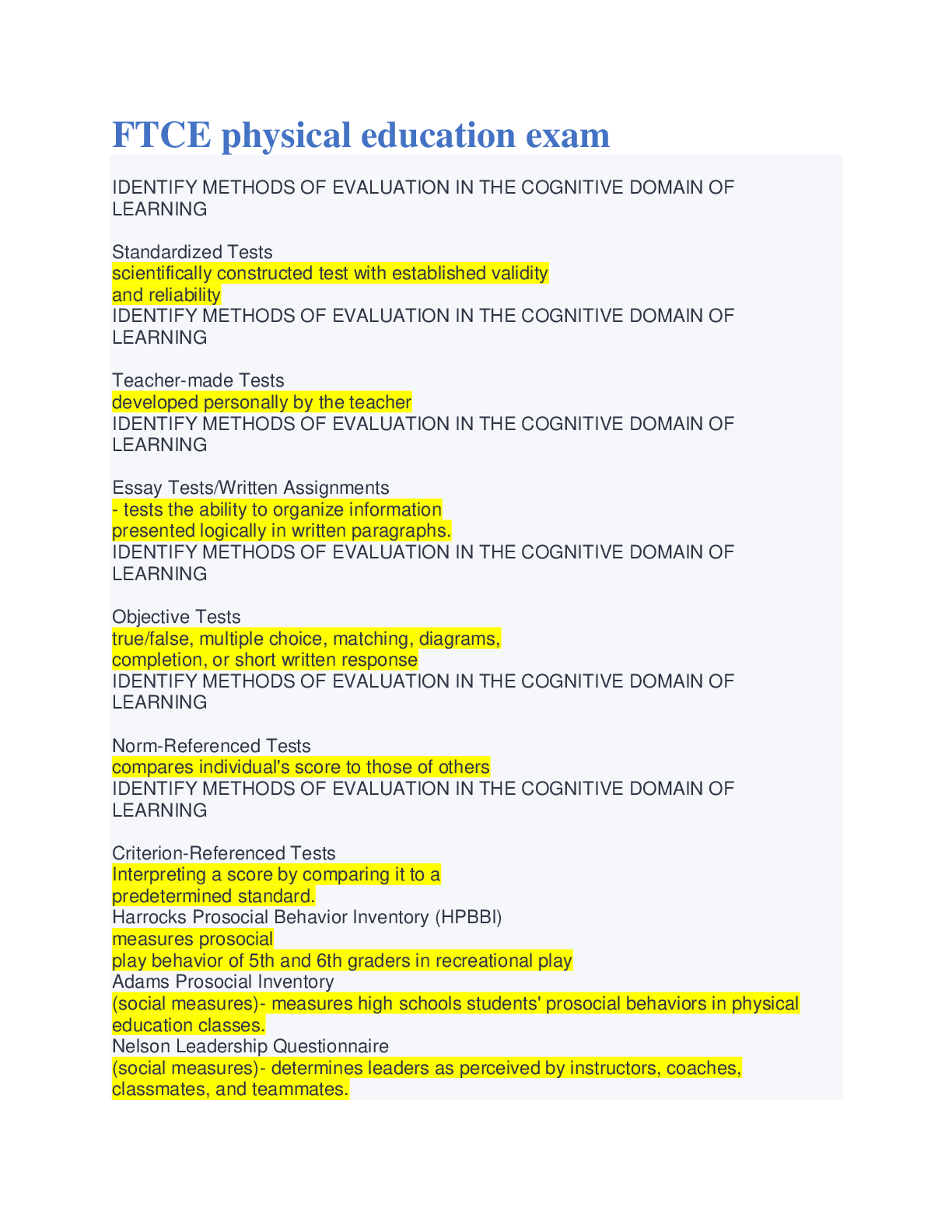Health Care > EXAM > Pharmacology Nursing TEST BANK QUESTIONS WITH COMPLETE SOLUTION| GRADED A (All)
Pharmacology Nursing TEST BANK QUESTIONS WITH COMPLETE SOLUTION| GRADED A
Document Content and Description Below
What are the major functions of the H1 receptor? Increase nasal and bronchial mucus production, increase vascular permeability, contraction of bronchioles, pruritis, pain What are the major func... tions of the H2 receptor? Increase gastric acid secretion Rivastigmine -Anticholinesterse - increases ACh -Alzheimer disease Ipratropium -Muscarinic antagonist -Used in COPD and asthma Scopalamine -Muscarinic antagonist -Motion sickness Albuterol -β2 > β1 direct agonist -Acute asthma Epinephrine -β > α direct agonist -Uses: anaphylaxis, asthma, open-angle glaucoma; α effects predominate at high doses. Significantly stronger effect at β2-receptor than norepinephrine. Norepinephrine -α1 > α2 > β1 direct agonist -Hypotension (butrenal perfusion). Significantly weaker effect at β2-receptor than epinephrine. Phenylephrine -α1 > α2 direct agonist -Uses: hypotension (vasoconstrictor), ocular procedures (mydriatic), rhinitis (decongestant) Amphetamine -Indirect general sympathetic agonist -reuptake inhibitor; also releases stored catecholamines -Narcolepsy, obesity, ADHD. levodopa/methyldopa Parkinsons Benzodiazepine used for nausea Lorazepam Heparin toxicity antidote Protamine sulfate Opioids toxicity antidote Naloxone, naltrexone tPA antidote Aminocaproic acid Warfarin toxicity antidote Vitamin K (delayed effect), fresh frozen plasma (immediate) Drugs that cause adrenocortical insufficiency glucocorticoid withdrawal Drugs that can cause thrombocytopenia Heparin Drug that cause gingival hyperplasia Phenytoin Drug that can cause myopathy statins Deficiency in this neurotransmitter can cause Parkinson-like symptoms Too little dopamine Drugs that cause GI bleeds NSAIDs Drug that acts on H2 that may warrant dose REDUCTION of other medications cimetidine Complementary medication that may warrant dose INCREASE of other meds St. John's wort Never take these MAOIs Signs of HIT decreased platelets and fever Non opioid antitussive Dextromethorphan Opioid antitussive codeine Most sedating antihistamine diphenyhdramine Can cause arrhythmia lidocaine if introduced systemically Drug used for seizures and diabetic neuropathy gabapentin Phenytoin is a ______ therapeutic drug with a target level of _____ to _____ narrow; 10; 20 Monitor for heparin PTT and thrombocytes Monitor for warfarin INR and PTT Enoxaparin is injected via what route subcutaneously Epistaxis Nose bleed Antidote for Eliquis There is none Oral contraceptives decrease the effects of ___ heparin Goal warfarin level 2-3x normal Goal PTT level 1.5-2.5x normal Treatment for clopidogrel OD plasmaphoresis _____ can increase bleeding potential of Plavix omeprazole Alteplase is only for _____ stroke ischemic TPA is contraindicated in a patient who has had a stroke less than ____ ago 3 months -stigmine AChE inhibitor -pam benzodiazepine side effects of pseudoephedrine increased BP and blood sugar pseudoephedrine and phenyepherine are decongestants aminocoproic acid is an anti-fibrinolytic black box warning for Plavix is _____ if this warning is ignored the patient may have ____ levels of clopidogrel and so you may need to _____ the dose inability to metabolize the drug, leading to cardiovascular events increased; decrease Eliquis (apixaban) is a anti Xa inhibitor if HIT occurs, you may administer FFP smoking causes an ______ in the metabolism of drugs increase proton pump inhibtors ____ the pH of the stomach increase take antacids _____ hours after meals 1-3 bacteria that causes gastric ulcers H. pylori medication that can cause c.diff protonix PPIs treat.... GERD, ulcerative colitis, and gastric ulcers monitor ______ function with H2 blockers hepatic LABAs are for _____ and SABAs are for ______ maintenance; acute attacks How long you need to wait between taking a LABA and a corticosteroid 2-5 minutes -lukast leukotriene receptor agonists the ____ and _____ method should be used to prevent _____ _____ while using glucocorticosteroids rinse and spit; fungal infections (thrush) example of expectorant guaifenesin blood in the stool hematachezia vomiting blood hematemesis hemostasis coagulation hematuria blood in the urine normal platelet count 150-400K PPIs can cause bone loss dont take antacids longer than 2 weeks Cephalosporin toxicity -Hypersensitivity reactions, autoimmune hemolytic anemia, disulfiram-like reaction, vitamin K deficiency. -Exhibit cross-reactivity with penicillins. -Increased nephrotoxicity of aminoglycosides. Mechanism of resistance of cephalosporins Structural change in penicillin-binding proteins (transpeptidases) Carbapenems -Imipenem, meropenem, ertapenem, doripenem -Imipenem is a broad-spectrum, β-lactamase- resistant carbapenem. Always administered with cilastatin (inhibitor of renal dehydropeptidase I) to decrease inactivation of drug in renal tubules -Use: gram-positive cocci, gram-negative rods, and anaerobes. Wide spectrum, but significant side effects limit use to life-threatening infections or after other drugs have failed. Meropenem has arisk of seizures and is stable to dehydropeptidase I -Toxicity: GI distress, skin rash, and CNS toxicity (seizures) at high plasma levels Aztreonam -Monobactam -Less susceptible to β-lactamases. Prevents peptidoglycan cross-linking by binding to penicillin- binding protein 3. -Synergistic with aminoglycosides. No cross-allergenicity with penicillins. -Gram-negative rods only—no activity against gram-positives or anaerobes. For penicillin-allergic patients and those with renal insufficiency who cannot tolerate aminoglycosides. -Usually nontoxic; occasional GI upset. Vancomycin -Inhibits cell wall peptidoglycan formation by binding D-ala D-ala portion of cell wall precursors. Bactericidal. Not susceptible to β-lactamases. -Gram-positive bugs only—serious, multidrug-resistant organisms, including MRSA, S. epidermidis, sensitive Enteroccocus species, and Clostridium difficile (oral dose for pseudomembranous colitis). -Well tolerated in general—but NOT trouble free. Nephrotoxicity, Ototoxicity, Thrombophlebitis, diffuse flushing—red man syndrome (can largely prevent by pretreatment with antihistamines and slow infusion rate). -Resistance occurs in bacteria via amino acid modification of D-ala D-ala to D-ala D-lac. "Pay back 2 D-alas (dollars) for vandalizing (vancomycin)." Aminoglycosides -Gentamicin, neomycin, amikacin, tobramycin, streptomycin -Bactericidal; irreversible inhibition of initiation complex through binding of the 30S subunit. Can cause misreading of mRNA. Also block translocation. Require O2 for uptake; therefore ineffective against anaerobes. -Severe gram-negative rod infections. Synergistic with β-lactam antibiotics. -Neomycin for bowel surgery. -Toxicity: Nephrotoxicity, Neuromuscular blockade, Ototoxicity (especially when used with loop diuretics). Teratogen. -Resistance: Bacterial transferase enzymes inactivate the drug by acetylation, phosphorylation, or adenylation. Tetracyclines -Tetracycline, doxycycline, minocycline -Bacteriostatic; bind to 30S and prevent attachment of aminoacyl-tRNA; limited CNS penetration. Doxycycline is fecally eliminated and can be used in patients with renal failure. Do not take tetracyclines with milk (Ca2+), antacids (Ca2+ or Mg2+), or iron-containing preparations because divalent cations inhibit drugs' absorption in the gut. -Clinical use: Borrelia burgdorferi, M. pneumoniae. Drugs' ability to accumulate intracellularly makes them very effective against Rickettsia and Chlamydia. Also used to treat acne. -Toxicity: GI distress, discoloration of teeth and inhibition of bone growth in children, photosensitivity. Contraindicated in pregnancy. -Resistance: decrease uptake or increased efflux out of bacterial cells by plasmid-encoded transport pumps. Chloramphenicol -Blocks peptidyltransferase at 50S ribosomal subunit. -Bacteriostatic. -Use: Meningitis (Haemophilus influenzae, Neisseria meningitidis, Streptococcus pneumoniae) and Rocky Mountain spotted fever (Rickettsia rickettsii). Limited use owing to toxicities but often still used in developing countries because of low cost. -Toxicity: anemia (dose dependent), aplastic anemia (dose independent), gray baby syndrome (in premature infants because they lack liver UDP-glucuronyl transferase). -Resistance: plasmid-encoded acetyltransferase inactivates the drug. Clindamycin -Blocks peptide transfer (translocation) at 50S ribosomal subunit. Bacteriostatic. -Anaerobic infections (e.g., Bacteroides spp., Clostridium perfringens) in aspiration pneumonia, lung abscesses, and oral infections. Also effective against invasive group A streptococcal infection. -Treats anaerobic infections above the diaphragm vs. metronidazole (anaerobic infections below diaphragm) -Toxicity: pseudomembranous colitis (C. difficile -overgrowth), fever, diarrhea Linezolid -Oxazolidinone -Inhibit protein synthesis by binding to 50S subunit and preventing formation of the initiation complex. -Gram-positive species including MRSA and VRE. -Toxicity: Bone marrow suppression (especially thrombocytopenia), peripheral neuropathy, serotonin syndrome. -Resistance: Point mutation of ribosomal RNA. [Show More]
Last updated: 2 years ago
Preview 1 out of 82 pages

Buy this document to get the full access instantly
Instant Download Access after purchase
Buy NowInstant download
We Accept:

Reviews( 0 )
$15.00
Can't find what you want? Try our AI powered Search
Document information
Connected school, study & course
About the document
Uploaded On
Sep 19, 2022
Number of pages
82
Written in
Additional information
This document has been written for:
Uploaded
Sep 19, 2022
Downloads
0
Views
60


















.png)




